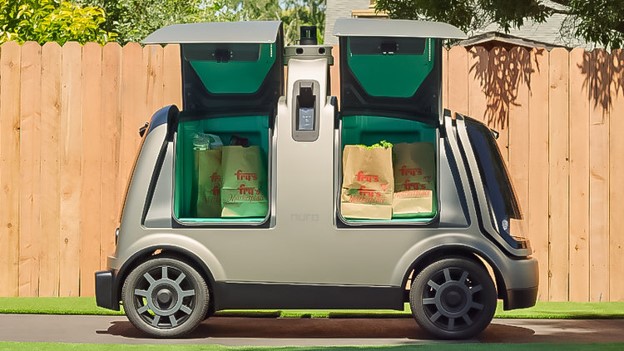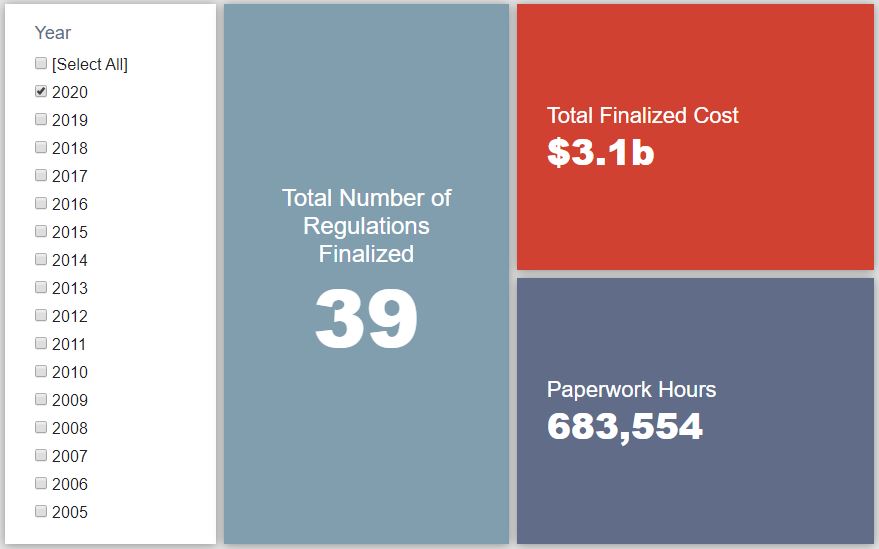Week in Regulation
February 18, 2020
A Pair of Deregulatory Measures Drives Week
In an otherwise uninspired week, two cost-cutting rules stood out. One, from the Small Business Administration (SBA), deals with loans to small businesses. The other, from the Department of Transportation (DOT), focuses on natural gas tanks. Across all rulemakings, agencies published $293 million in total net cost savings but added 102,023 hours of annual paperwork.
REGULATORY TOPLINES
- 2020 Proposed Rules: 61
- 2020 Final Rules: 66
- 2020 Total Pages: 8,695
- 2020 Final Rule Costs: $3.1 billion
- 2020 Proposed Rule Costs: $3.6 billion
TRACKING THE REGULATORY BUDGET
The two main rules of the week brought some noticeable downward pressure to the fiscal year (FY) 2020 regulatory budget tally. The SBA rule regarding “Express Loan Programs; Affiliation Standards” streamlines certain administrative requirements under the Express Loan program. SBA estimates that this could yield nearly $13 million in annual savings (or $180 million in present value). The DOT rule regarding “Pipeline Safety: Safety of Underground Natural Gas Storage Facilities” make certain adjustments to a interim final rule from 2016 that the agency estimates will save affected facilities roughly $11 million annually (or $157 million in present value).
The Trump Administration expects to reach $51.6 billion in cumulative net savings in FY 2020. To date in the fiscal year, agencies have finalized 54 deregulatory actions and 15 regulatory actions, totaling $2 billion in quantified total net costs.
THIS WEEK’S REGULATORY PICTURE
This week, the National Highway Traffic Safety Administration (NHTSA) issues its first exemption from vehicle safety standards for an automated vehicle.
NHTSA published a notice in the February 11 edition of the Federal Register that it had granted a petition to Nuro, Inc. to be exempt from certain Federal Motor Vehicle Safety Standards (FMVSS) for automated vehicle, the R2X, pictured below. It marks the first time NHTSA has granted an exemption to a vehicle with an automated driving system (ADS) under its general exemption authority, according to the agency.

Via Nuro.ai
Nuro’s vehicle is designed to transport cargo in local areas. It is classified as a low-speed vehicle (LSV), which means it can go at least 20 miles per hour (mph) but not more than 40 mph. Nuro petitioned NHTSA for an exemption to the safety standard for LSVs, FMVSS No. 500. Nuro sought three specific exemptions that it argued would not make the vehicle less safe than if it complied with the standards.
The first is the requirement that the vehicle have mirrors. The second is that its windshield be glazed to prevent shattering. The third is that the backup camera must shut off when the vehicle is not in reverse. Since these standards are all meant for the use and safety of human drivers, Nuro reasoned that its driverless vehicle and its array of cameras and sensors nullify the need for these specific requirements.
NHTSA agreed, and cited two bases in granting the exemption: that it would make testing the vehicle easier while not unreasonably lowering the safety standard, and that compliance with the standard would “prevent the manufacturer from selling a motor vehicle with an overall safety level at least equal to the overall safety level of nonexempt vehicles.”
NHTSA’s granting of the exemption is a major milestone in the development of automated vehicles and helps sets a precedent for future exemptions so that ADS technology can be developed.
TOTAL BURDENS
Since January 1, the federal government has published $6.7 billion in total net costs (with $3.1 billion in finalized costs) and 12.8 million hours of net annual paperwork burden increases (with 683,554 hours due to final rules). Click here for the latest Reg Rodeo findings.












